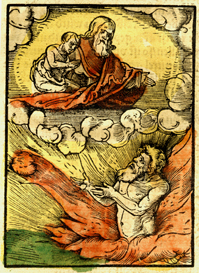I had written this a few months ago in response to an inquiry made to me regarding the story Jesus told in Luke 16. I had forgotten about it until I read a commentary by a friend of mine, Sean Finnegan called "The Rich Man and Lazarus." This was posted on his new web site Restitutio. In his commentary, he gives far more detail then I do here. So if this subject peaks your interest, check it out.
He has podcasts and explores many other interesting subjects relating to theology and Church history as well.
The
story Jesus told in Luke 16 has been frequently used in an attempt to support
the doctrine of conscious eternal torment. There are - in this reading of "the
Rich man and Lazarus" - some vital elements missing and assumptions made not
inherent within this text or indigenous to the context.
In
a brief overview, several observations can be safely made:
First,
this is a parable, not history or a factual narrative. This, like many parables
or stories Jesus told has borrowed content (i.e. a well-known story tweaked to
illustrate his point). "There was a certain rich man..." and
"there was a certain beggar..." Two chapters later in Luke, it says,
"Now he told them a parable" (Lk. 18) and then the parable in the
same form as Luke 16, "in a certain
city there was a judge....there was a widow in that city..." (emphasis
mine). Unknown to many New Testament gospel readers today is that few of Jesus'
parables are actually original to him. He borrowed stories from other Rabbis as
well as popular stories or folklore known in his day (Aesop etc.). Therefore, it
must be understood that just because Jesus uses a story from his day, does not necessarily
mean he endorsed all the elements in the story as fact or theologically sound. That
wasn’t why he was using the story. He uses the story to illustrate his own
teaching point.
Second,
the subject and interaction that culminates in Jesus telling this parable does
not concern afterlife, hell, conscious eternal torment, final judgment or
anything resembling these ideas. This is important, because a parable is meant
to teach a particular principle. Afterlife has nothing to do with the theme of
Jesus' context he is communicating to his listeners. Rather, it is a message to
the Pharisees about their failure to be good stewards. Luke says "they
were lovers of money" and were scoffing at him [Jesus]." Jesus speaks
of having ones heart right before God, because he [God] detests what may be
seen as "highly esteemed" among men.
Jesus
here is threatening the order of civil structure (such themes as “first shall
be last and last shall be first”). In the parable, a man who was honored by man
and had the luxuries of life now inhabits a lower place than he who was
despised. He ends the parable speaking about “those” relatives of the “rich
man” (other Pharisees) who would not be persuaded by Moses and the prophets (perhaps
this was Jesus’ allusion to the Scripture over their love of tradition and oral
Torah) and then gives a hint about not being persuaded even if “one should rise
from the dead.” This is of course a preamble to what Jesus was about to do (Lk.
16:27-31). In the story, Abraham’s words “they would not believe,” prove
to be true, because after Jesus’ resurrection in Luke, the same attitude is
exhibited.
Third,
if the setting is examined, the time frame of "here and now," cannot
be escaped. It was in the present age, not some distant time in the future.
This action has taken place before any type of judgment and is taking place in
hades, the realm of the dead (equivalent to Sheol in the Old Testament, the
place of the dead, not the place of conscious eternal torment) not Gahanna, the
final punishment. It simply refers to the grave.
Fourth
and finally, the story is figurative, not literal. If this story were read as
literal, some convoluted propositions would be presented:
1. Abraham
is in charge and receives all the righteous dead and remains with them.
2. The
“righteous” on Abraham’s side can travel back to give messages to the world of
the living (opposed to the realm of the dead, hades/sheol).
3. Physical
water (a drop) has immaterial properties capable of relieving the anguish or
torments of a disembodied spirit in the grave.
4. Disembodied
souls or spirits have physical attributes (eyes, tongue, etc.) and can use
senses present in corporeal bodies.
5. Angels
transport the dead (although in immaterial form – a disembodied soul) from
earth to Abraham (wherever that may be).
6. The
righteous dead are within audible and visible proximity to each other and have
the ability to communicate.
In Jesus’ version this story, the
messed-up social structure of the “rich” versus the “poor” man becomes evident.
Even in his predicament, the rich man still wants the poor man to serve him
(“send Lazarus to me…that he may cool my tongue”). Jesus is teaching
about stewardship and the necessity of his people to take up their God-given
responsibilities to care for the broken, hurting sick and torn instead of
living vicariously and sumptuously. Jesus exhibited what he taught, he healed
the sick and cared for the broken (even at times going against the established
“tradition”). This story (parable) is not about final judgment, does not teach
the immortality of the soul, conscious eternal torment or any “Heavenly abode”
for the saints, but rather was a real message to real people who were missing
the calling and mission of their God. This message is just as relevant for
people of God today as it was then.



No comments:
Post a Comment